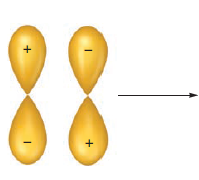
Concept explainers
(a)
Interpretation:
The molecular orbital formed by overlapping of atomic orbitals should be sketch and labeled.

Concept Introduction:
Molecular orbital theory is a method that shows that how atomic orbitals combine with other or with each other to form bonding and antibonding orbitals. It is used to determine the molecular structure of a molecule.
(b)
Interpretation:
The molecular orbital formed by overlapping of atomic orbitals should be sketch and labeled.

Concept Introduction:
Molecular orbital theory is a method that shows that how atomic orbitals combine with other or with each other to form bonding and antibonding orbitals. It is used to determine the molecular structure of a molecule.
(c)
Interpretation:
The molecular orbital formed by overlapping of atomic orbitals should be sketch and labeled.

Concept Introduction:
Molecular orbital theory is a method that shows that how atomic orbitals combine with other or with each other to form bonding and antibonding orbitals. It is used to determine the molecular structure of a molecule.
(d)
Interpretation:
The molecular orbital formed by overlapping of atomic orbitals should be sketch and labeled.

Concept Introduction:
Molecular orbital theory is a method that shows that how atomic orbitals combine with other or with each other to form bonding and antibonding orbitals. It is used to determine the molecular structure of a molecule.
Want to see the full answer?
Check out a sample textbook solution
Chapter 14 Solutions
Chemical Principles
- Compare and contrast the molecular orbital and ionic bonding descriptions of LiF.arrow_forwardElectrons in bonding molecular orbitals are most likely to be found in the region between the two bonded atoms. Why does this arrangement favor bonding? In a antibonding orbital, where are the electrons most likely to be found in relation to the nuclei in a bond?arrow_forwardGive the hybridization of each central atom in the following molecules. (a) cyclohexene (b) phosgene, Cl2CO (c) glycine, H2NC(1)H2C(2)OOH (Note: Numbers in parentheses label each carbon atom.)arrow_forward
- Predict the valence electron molecular orbital configurations for the following, and state whether they will be stable or unstable ions. (a) Na,2+ (b) Mg,2 (c) AI,2 (d) Si,2 (e) p2+ (f) s,2 (g) F,2 (h) Ar,2 40. Predict the valence electron molecular orbital configurations for the following, and state whether they will be stable or unstable ions. (a) Na22+ (b) Mg22+ (c) Al22+ (d) Si22+ (e) P22+ (f) S22+ (g) F22+ (h) Ar22+arrow_forwardA neutral molecule is identified as a tetrafluoride, XF4, where X is an unknown atom. If the molocule has a dipole moment of 0.63 D, can you give some possibilities for the identity of X?arrow_forwardIn the molecular orbital mode l, compare and contrast bonds with bonds. What orbitals form the bonds and what orbitals form the bonds? Assume the z-axis is the internuclear axis.arrow_forward
- Do lone pairs about a central atom affect the hybridization of the central atom? If so, how?arrow_forwardThe bond length in C2 is 131 pm. Compare this with the bond lengths in C2H2 (120 pm), C2H4 (134 pm), and C2H6 (153 pm). What bond order would you predict for C2 from its bond length? Does this agree with the molecular orbital configuration you would predict for C2?arrow_forwardIdentify the hybrid orbitals used by antimony in SbCl5 and in SbCl6, the ion formed from the reaction of SbCl5 and Cl. Explain your choices.arrow_forward
- What are the bond angles predicted by the VSEPR model about the carbon atom in the formate ion, HCO2? Considering that the bonds to this atom are not identical, would you expect the experimental values to agree precisely with the VSEPR values? How might they differ?arrow_forwardSpecify the electron-pair and molecular geometry for each underlined atom in the following list. Describe the hybrid orbital set used by this atom in each molecule or ion. (a) CSe2 (b) SO2 (c) CH2O (d) NH4ssarrow_forwardWhy is the concept of hybridization required in valence bond theory?arrow_forward
 ChemistryChemistryISBN:9781305957404Author:Steven S. Zumdahl, Susan A. Zumdahl, Donald J. DeCostePublisher:Cengage Learning
ChemistryChemistryISBN:9781305957404Author:Steven S. Zumdahl, Susan A. Zumdahl, Donald J. DeCostePublisher:Cengage Learning
 Chemistry: An Atoms First ApproachChemistryISBN:9781305079243Author:Steven S. Zumdahl, Susan A. ZumdahlPublisher:Cengage Learning
Chemistry: An Atoms First ApproachChemistryISBN:9781305079243Author:Steven S. Zumdahl, Susan A. ZumdahlPublisher:Cengage Learning Chemistry: Principles and PracticeChemistryISBN:9780534420123Author:Daniel L. Reger, Scott R. Goode, David W. Ball, Edward MercerPublisher:Cengage Learning
Chemistry: Principles and PracticeChemistryISBN:9780534420123Author:Daniel L. Reger, Scott R. Goode, David W. Ball, Edward MercerPublisher:Cengage Learning General Chemistry - Standalone book (MindTap Cour...ChemistryISBN:9781305580343Author:Steven D. Gammon, Ebbing, Darrell Ebbing, Steven D., Darrell; Gammon, Darrell Ebbing; Steven D. Gammon, Darrell D.; Gammon, Ebbing; Steven D. Gammon; DarrellPublisher:Cengage Learning
General Chemistry - Standalone book (MindTap Cour...ChemistryISBN:9781305580343Author:Steven D. Gammon, Ebbing, Darrell Ebbing, Steven D., Darrell; Gammon, Darrell Ebbing; Steven D. Gammon, Darrell D.; Gammon, Ebbing; Steven D. Gammon; DarrellPublisher:Cengage Learning Chemistry by OpenStax (2015-05-04)ChemistryISBN:9781938168390Author:Klaus Theopold, Richard H Langley, Paul Flowers, William R. Robinson, Mark BlaserPublisher:OpenStax
Chemistry by OpenStax (2015-05-04)ChemistryISBN:9781938168390Author:Klaus Theopold, Richard H Langley, Paul Flowers, William R. Robinson, Mark BlaserPublisher:OpenStax





